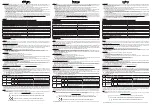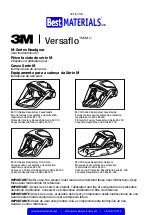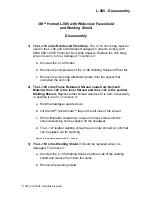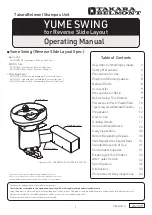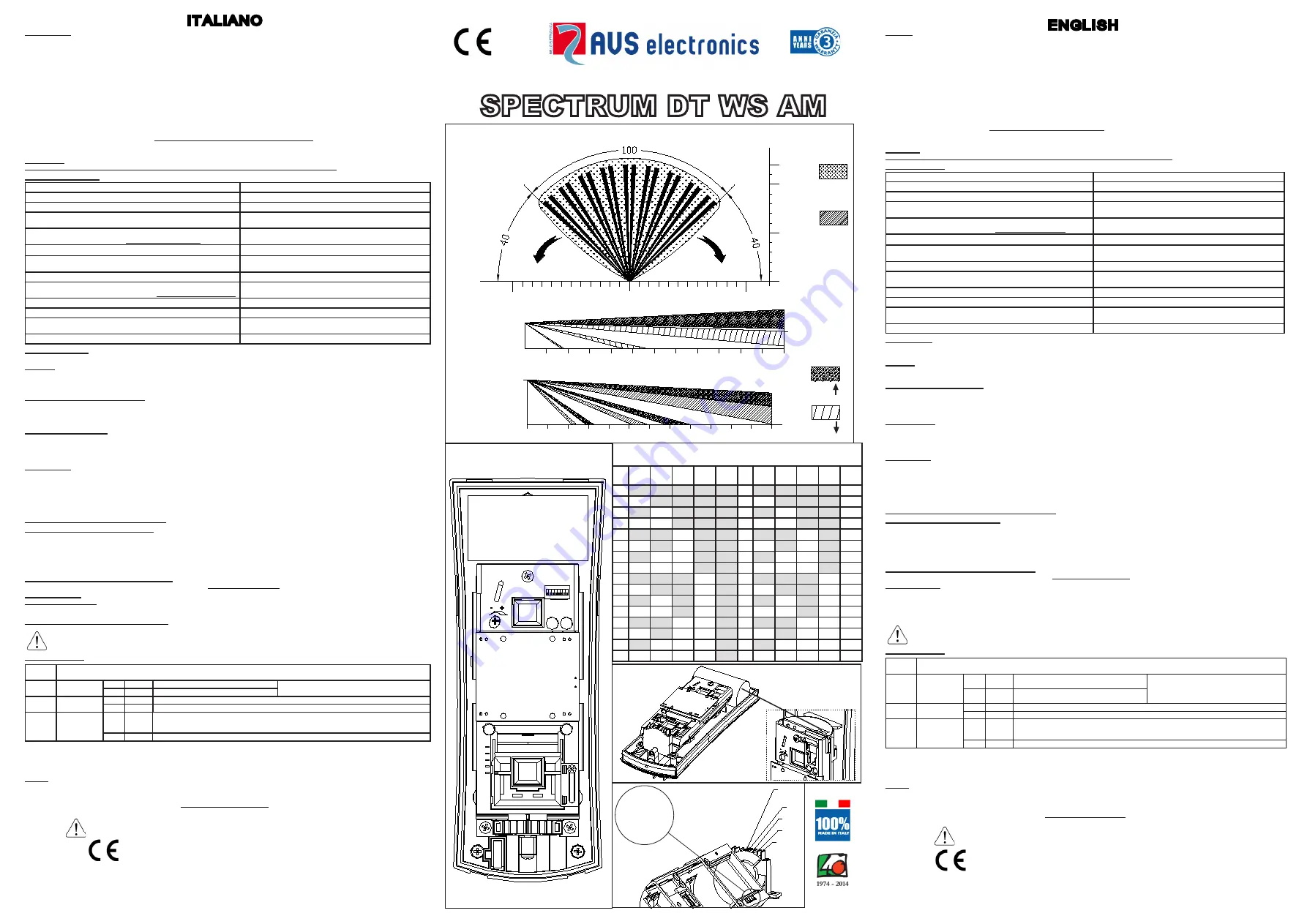
Curtarolo (Padova) Italy
www.avselectronics.com
ist0921V1.9
Caratteristiche
- E’ un rilevatore volumetrico di movimento, composto da
un doppio infrarosso e da una microonda planare
, ideato per la protezione
sia interna che esterna.
- E’ progettato per la protezione di aree esterne e per ridurre al minimo il rischio di falsi allarmi dovuti a condizioni meteorologiche, elementi
ambientali, animali in libertà, ecc...
- Ha integrato un modulo di trasmissione via radio a singola frequenza compatibile con ricevitori e centrali AVS Electronics,
- E’ dotato di un
buzzer e di led
per dare una segnalazione ottico-acustica (Walk Test).
- E’ dotato di:
• Compensazione termica
, il sensore compensa automaticamente la portata al variare della temperatura ambiente, ciò nonostante
la resa del sensore può variare sensibilmente in funzione di particolari intervalli di temperature.
• Filtri di protezione contro la luce bianca e quella solare,
per ottimizzare la lettura degli infrarossi
• Accelerometro
, per la segnalazione dello strappo (non rileva la vibrazione). Una eventuale rimozione non autorizzata viene segnalata
dal sensore come TAMPER.
• Antimascheramento infrarosso,
formato da un ricevitore ed un tramettitore ad infrarossi attivi, che rileva gli ostacoli posti di fronte
al sensore fino ad una distanza di circa 5 cm. La calibrazione avviene alla chiusura del TAMPER (Contenitore e, se presente, Anti-
strappo) e dura circa 40 secondi, durante i quali il led Giallo lampeggia lentamente. La segnalazione viene generata dopo circa 60
secondi dal rilevamento dell’ostacolo. La segnalazione si resetta alla rimozione dell’ostacolo.
- E’ dotato di
Mascherine Adesive Oscuranti
per ridurre l’angolo di copertura, o mascherare una zona specifica.
- Può essere dotato di una
TETTOIA
protettiva opzionale (
Mod. SSC PROTEZIONE FRONT
)
Installazione
Per l’apertura e l’installazione del sensore vedi le illustrazioni stampate nella parte interna della confezione.
Caratteristiche tecniche
Tensione nominale
3,6 V =
Tensione di alimentazione
Max: 3,6 V = / Min: 3 V =
Assorbimento
15 µA in quiete / 34 mA in allarme
Batteria al Litio in dotazione Modello SIZE AA
Batteria al Litio opzionale Modello C - SIZE
3.6 V = 2,6 Ah
3.6 V = 7,7 Ah
Copertura con lente in dotazione:
Copertura con lente opzionale (Mod. SSL LENTE H 2,20):
100° su 12 metri effettivi
100° su 12 metri effettivi
Antimascheramento infrarosso
sì
Frequenza microonda
- Paesi della Comunità Europea eccetto Germania: 10,525 GHz
- Germania: 9,350 GHz
Segnale emesso dalla microonda
Impulsato
Altezza installazione con lente in dotazione
Altezza installazione con lente opzionale (Mod. SSL LENTE H 2,20)
da 1,2 a 1,5 metri da terra
2,2 metri da terra
Condizioni funzionamento scheda elettronica
-25° C / +55° C
Peso (grammi)
300
Dimensioni senza TETTOIA (millimetri) (PxLxH)
Dimensioni con TETTOIA (millimetri) (PxLxH)
68,3 x 75,4 x 189,4
87,3 x 75,4 x 189,4
Grado di protezione
IP 55
Prima alimentazione
Collegare la batteria nel connettore evidenziato in
FIG. G
, il sensore rimane in blocco per circa 60 secondi, durante i quali i led lampeggiano.
Walk Test
Alla prima alimentazione e ogni volta che si apre e chiude il coperchio, il sensore entra in modalità walk-test per 30 minuti, durante i quali
il led blu e il buzzer sono attivi e segnalano quando c’è l’allarme, e il sensore e pronto per rilevare un nuovo allarme dopo 10 secondi,
indipendentemente dal DIP6
.
Funzionamento LED durante Walk test
LED BLU:
durante l’inizializzazione questo led lampeggia per 60 secondi. Durante il walk-test si accende per 1 secondo quando il sensore va in allarme.
LED GIALLO:
durante l’inizializzazione e la calibrazione dell’antimask questo led lampeggia ma resta acceso fisso se la calibrazione non avviene
in modo corretto. Lampeggia ogni uno o due secondi quando il sensore rileva una condizione di mascheramento.
Modalità di funzionamento
AND:
Il sensore trasmette l’allarme solo quando entrambe le tecnologie rilevano contemporaneamente
-
CONSUMO NORMALE (DIP 6 in ON):
rileva e trasmette gli allarmi con un tempo di inibizione di 10 secondi.
-
CONSUMO RIDOTTO (DIP 6 in OFF):
In seguito ad una trasmissione di allarme, il sensore continua ad analizzare l’ambiente da pro-
teggere ma non esegue un’ulteriore trasmissione se non dopo un periodo di circa 3 minuti.
Accelerometro
Per abilitare / disabilitare l’accelerometro procedere come segue:
- inserire la batteria
• se l’accelerometro è inserito il led blu e il led giallo lampeggiano contemporaneamente.
• se l’accelerometro è disinserito lampeggia solo il led giallo
- per cambiare di stato, entro 10 secondi dall’inserimento della batteria, premere e rilasciare il tamper 3 volte di fila
• al disinserimento dell’accelerometro, il cicalino emette due beep ed il led blu si spegne
• all’inserimento dell’accelerometro, il cicalino emette un beep singolo ed il led blu inizia a lampeggiare in sincronia con il led giallo
In caso di errore, ripetere l’operazione dall’inizio.
Portata Infrarosso
(
vedi FIG. F dettaglio 1
- Installazione
da 1,2 a 1,5 metri
dal terreno (
FIG. B
): è possibile modificare la portata dell’infrarosso
da 12 a 3 metri
variando l’altezza
del
PIR inferiore da 5 a 1 e, se necessario, posizionando il DIP 8 in ON.
Per variare l’altezza del PIR è necessario allentare la
Vite 1 in FIG. D
. Rifissarla per bloccare il PIR nella posizione desiderata.
- Installazione
a 2,2 metri
dal terreno (
FIG. C
): la portata è fissa a
12 metri
, il
PIR inferiore
dev’essere necessariamente sulla
posizione
1 e orizzontale su 0°
(vedi Copertura).
NOTA:
L’efficacia massima della copertura, si ha installando il sensore perpendicolarmente al terreno.
Portata Microonda (Vedi Trimmer MW in FIG. D)
La portata della microonda è regolabile tramite il Trimmer
MW
. Aumenta in senso orario.
Copertura (FIG. A)
Con lente in dotazione:
Installazione
da 1,2 a 1,5 metri
dal terreno (
FIG. B
), la scheda elettronica può essere ruotata orizzontalmente per
variare l’angolo di copertura che rimane comunque di 100° su 180° disponibili (
vedi FIG. F dettaglio 2
). Per ruotare la scheda è necessario
allentare la
Vite 2 in FIG. D
, rifissarla per bloccare la scheda nella posizione desiderata.
Con lente opzionale (Mod. SSL LENTE H 2,20)
: Installazione
a 2,2 metri
dal terreno (
FIG. C
), la copertura è di 100°. La scheda elettronica
deve essere fissata nella posizione orizzontale a
0°
(
vedi FIG. F dettaglio 2
).
In alcune circostanze il sensore potrebbe rilevare bersagli in movimento, specialmente nelle vicinanze, ad angolazioni oltre i 100°
nominali di copertura. Si consiglia perciò di mascherare preventivamente con gli appositi adesivi in dotazione i settori di lente che
non fanno parte della zona di rilevazione desiderata.
Dip Switch (FIG. D)
da DIP 1
a DIP 5
INDIRIZZAMENTO SENSORE (
Vedi Figura E
)
Negli impianti realizzati con la centrale Concorde Plus WS, non sono disponibili le zone 9,10,19,20,29,30
DIP 6
CONSUMO
ON Default
Consumo Normale (stand by: 10 secondi)
Sia in CONSUMO NORMALE che in CONSUMO
RIDOTTO il WALK TEST rimane attivo per 30 minuti.
OFF
Consumo Ridotto (stand by: 3 minuti)
DIP 7
ANTIMASK
ON
Antimak
Attivo
OFF Default Antimask
Disabilitato
DIP 8
PORTATA
SENSIBILITÀ
ON
Ridotta:
da utilizzare per ridurre ulteriormente la portata se lo spostamento della slitta (vedi
FIG. F dettaglio 2
) non fosse sufficiente. La microonda esegue un’analisi digitale dei segnali più
severa che tende ad escludere l’oscillazione delle piante sotto l’azione del vento.
OFF Default Normale
In caso di installazioni su tetti di capannoni o edifici in genere, particolarmente dove ci sono lucernari o altre superfici riflettenti o pavi-
mentazioni in asfalto che subiscono forte riscaldamento per l’irraggiamento del sole, si raccomanda usare la modalità a sensibilità ridotta
dell’infrarosso, in quanto, tali fattori, favoriscono l’insorgenza di falsi allarmi. In ogni caso, regolare sempre correttamente la sensibilità della
microonda al valore minimo indispensabile e non oltre.
Tamper
- Il TAMPER antiapertura del coperchio è già installato e cablato di fabbrica.
- Il TAMPER antistrappo opzionale da installare sul fondo del sensore (Cod.1135112) è necessario collegarlo in serie al TAMPER antiapertura.
Dichiarazione di Conformità
La dichiarazione di conformità può essere consultata nell’area riservata del sito
AVS Electronics.com
INSTALLAZIONE E MANUTENZIONE DEVONO ESSERE FATTE DA PERSONALE QUALIFICATO
Il prodotto è conforme alla direttiva CE per la compatibilità elettromagnetica.
AVS ELECTRONICS S.p.a
. si riserva il diritto di apportare modifiche in qualsiasi momento e senza preavviso.
SPECTRUM DT WS AM
MW
PIR
A
10m
10m
5m
5m
12m
0
12 m
0
5
10
12m
2,2 m
0m 1m 2m 3m 4m 5m 6m 7m 8m 9m 10m 11m 12m
LD1 LD2
ON
1 2 3 4 5 6 7 8
1
2
3
4
5
B
C
D
F
45°
31°
18°
5°
0°
1 - 3 mt
2 - 5 mt
3 - 7 mt
4 - 9 mt
5 - 12 mt
1
2
MW
1
2
TAMP.
SP Lens 2,2 m
1,2 m
0m 1m 2m 3m 4m 5m 6m 7m 8m 9m 10m 11m 12m
0.8 m
SP Lens 1,2 m
1,2 m
0m 1m 2m 3m 4m 5m 6m 7m 8m 9m 10m 11m 12m
0.8 m
1,2 m
0m 1m 2m 3m 4m 5m 6m 7m 8m 9m 10m 11m 12m
0.8 m
PIR
PIR
G
E
- DIP SWITCH
N°
DIP
1
DIP
2
DIP
3
DIP
4
DIP
5
N°
DIP
1
DIP
2
DIP
3
DIP
4
DIP
5
1
ON
ON
ON
ON
ON
17
ON
ON
ON
ON
OFF
2
OFF
ON
ON
ON
ON
18 OFF
ON
ON
ON
OFF
3
ON
OFF
ON
ON
ON
19
ON
OFF
ON
ON
OFF
4
OFF OFF
ON
ON
ON
20 OFF OFF
ON
ON
OFF
5
ON
ON
OFF
ON
ON
21
ON
ON
OFF
ON
OFF
6
OFF
ON
OFF
ON
ON
22 OFF
ON
OFF
ON
OFF
7
ON
OFF OFF
ON
ON
23
ON
OFF OFF
ON
OFF
8
OFF OFF OFF
ON
ON
24 OFF OFF OFF
ON
OFF
9
ON
ON
ON
OFF
ON
25
ON
ON
ON
OFF OFF
10 OFF
ON
ON
OFF
ON
26 OFF
ON
ON
OFF OFF
11
ON
OFF
ON
OFF
ON
27
ON
OFF
ON
OFF OFF
12 OFF OFF
ON
OFF
ON
28 OFF OFF
ON
OFF OFF
13
ON
ON
OFF OFF
ON
29
ON
ON
OFF OFF OFF
14 OFF
ON
OFF OFF
ON
30 OFF
ON
OFF OFF OFF
15
ON
OFF OFF OFF
ON
31
ON
OFF OFF OFF OFF
16 OFF OFF OFF OFF
ON
32 OFF OFF OFF OFF OFF
IT ALIANO
ENGLISH
Features
- It is a wired volumetric motion detector with
dual infrared sensor and planar microwave
designed for both internal and external protection.
- Sensor designed for the protection of outdoor areas and the minimisation of the risk of false alarms due to weather conditions, environ-
mental elements, animals, etc
- Integrates a single-frequency radio transmission module that is compatible with receivers and controllers from AVS Electronics.
- It has a
buzzer and LED
for the optical and sound alarm signalling function (Walk Test).
- It is equipped with:
• Thermal compensation
, whereby the sensor automatically adjusts the performance of the system to compensate for changes in
ambient temperature. Its own performance can, however, vary considerably in relation to particular temperature ranges.
• White light and solar filters
to optimise performance of the infrared sensors
•
Accelerometer
that indicates tampering (does not detect vibration). The sensor indicates unauthorised removal as a TAMPER event.
•
Anti-masking with infrared
, comprising an receiver and a transmitter with active infrared that detect obstacles at a distance of about
10 cm in front of the sensor. Calibration occurs after closing of the TAMPER device (Container and Anti-tear device, when applicable)
and takes about 40 seconds, during which time the yellow LED flashes slowly. The signal is generated after about 60 seconds from
the detection of the obstacle. Removing the obstacle stops the signal.
- It has Adhesive Masks for reducing the angle of coverage or masking a specific area
- It can be equipped with an optional protective ROOF (Mod. SSC FRONT PROTECTION)
Installation
For opening and installation of the sensor see the illustrations printed on the inside of the package.
Technical Features
Rated voltage
3,6 V =
Power supply
Max: 3,6 V = / Min: 3 V =
Absorption
15 µA idle / 34 mA in alarm mode
Lithium battery - AA SIZE type
Lithium battery - C-SIZE type (optional)
3.6 V = 2,6 Ah
3.6 V = 7,7 Ah
Coverage area with the lens provided:
Coverage area with optional lens (Mod. SSL LENS H 2,20):
100° effectively for 12 metres
100° effectively for 12 metres
Anti-masking with infrared
yes
Microwave frequency
- European Community countries except Germany: 10.525 GHz
- Germany: 9,350 GHz
Microwave signal
Pulsed
Height of installation with lens provided
Height of installation with optional lens (Mod. SSL LENS H 2.20)
1.2 to 1.5 metres above the ground
2.2 metres above the ground
Operating conditions of the printed circuit board
-25° C / +55° C
Weight (grams)
300
Dimensions without ROOF (millimetres) (WxLxH)
Dimensions with ROOF (millimetres) (WxLxH)
68,3 x 75,4 x 189,4
87,3 x 75,4 x 189,4
Degree of protection
IP 55
First Power-On
Connect the battery to the electronic board as indicated in figure FIG. G, the detector is kept in stand-by for about 60 seconds, during which
the LEDs blink.
Walk Test
At power up and each time the front cover is open and closed, the detector enters in walk-test mode for about 30 minutes. The LEDs and
BUZZER are enabled to give optical and acoustical signal of alarm detection and the detector is ready to detect a new alarm after 10 seconds
LED operation during Walk Test
BLUE LED:
during initialization this LED blinks for 60 seconds (see note below for AM model). During walk-test it goes ON for 1 second
when there is an alarm.
YELLOW LED:
during sensor initialization and antimask calibration this LED blink, but stay ON if the antimask calibration is not correct and
must be repeated. They blink each one or two seconds in the corresponding side when detecting a masking condition.
Operating mode
AND:
the detector transmit the alarm signal only when both the technologies detect in the same moment
-
NORMAL CONSUMPTION (DIP 6 in ON):
detect and transmit the alarm each 10 seconds.
-
LOW CONSUMPTION (DIP 6 in OFF):
After an alarm transmission, the detector continues to analyze the surrounding space but won’t
transmit anymore, at least for the following 3 min.
Accelerometer
To enable/disable the Accelometer follow the following indication:
- insert the battery
• if the Accelerometer is active the BLUE and the YELLOW LEDs will flash simultaneously.
• If the Accelerometer is not active, only the YELLOW LED will flash
- To change the status, within 10 seconds from the battery connection, press and release 3 times the tamper switch button
• when the Accelerometer is disabled the buzzer will sound 2 times and the BLUE LED will switch off
• when the Accelerometer is enabled the buzzer will sound 1 time and the BLUE and the YELLOW LEDs will flash simultaneously
If an error occurs, repeat the operation from the beginning.
Infrared capacity (see FIG. F detail 1)
- Installation
1.2 to 1.5 metres
above the ground (
FIG. B
): it is possible to change infrared capacity
from 12 to 3 metres
by changing the
height of the
lower PIR from 5 to 1
and, if necessary, by placing the DIP 8 to ON
.
To change the height of the PIR, loosen
Screw 1 in FIG. D
. Refasten it to lock the PIR in the required position.
- Installation
2.2 metres
above the ground (
FIG. C
): capacity is set at
12 metres
, the
lower PIR
must be at
position 1 and horizontal at
0°
(see Coverage).
NOTE:
The sensor should ideally be installed perpendicular with the ground for optimal adjustment of capacity.
Microwave capacity (See MW Trimmer in FIG. D)
Microwave capacity can be adjusted at the
MW
Trimmer. Turn clockwise to increase.
Coverage (FIG. A)
With the lens provided:
Installation
1.2 to 1.5 metres
above the ground
(FIG. B)
, the printed circuit board can be turned horizontally to
change the angle of coverage which remains in any case 100° out of the available 180°
(see FIG. F detail 2)
. To turn the printed circuit
board, loosen
Screw 2 in FIG. D
. Refasten it to lock the printed circuit board in the required position.
With optional lens (Mod. SSL LENS H 2.20):
Installation
2.2 metres
above the ground
(FIG. C)
, the coverage is of 100°. The printed circuit
board must be locked in the horizontal position at 0°
(see FIG. F detail 2
).
In some circumstances, the sensor could detect moving targets, especially closed, at angles above 100 ° of nominal coverage. It
is better to mask preventively the lens sectors which are not part of the desired detection area, thanks to appropriate provided sti-
ckers.
Dip Switch (FIG. D)
from DIP 1
to DIP 5
SENSOR ADDRESS (
See Fig. E
)
In the systems with Concorde Plus WS the following zones are not available 9,10,19,20,29,30
DIP 6
CONSUMPTION
ON Default
Normal consumption (stand-by 10 sec)
The WALK TEST mode is hold active for 30
minutes either in normal power mode or in
low power mode.
OFF
Reduced Consumption (stand-by: 3 minutes)
DIP 7
ANTIMASK
ON
Anti-mask
Active
OFF Default Anti-mask
Disabled
DIP 8
CAPACITY
SENSIVITY
ON
Reduced:
to be used to further reduce the flow rate if the displacement of the slide (
see FIG.
F detail 2
) was not enough. The microwave section performs a more severe digital signal
analysis that tends to exclude the oscillations from plants under the wind action.
OFF Default Normal
In case of roof installations in industrial or civil buildings in general, especially if skylights or other reflective surfaces are present, and/or
asphaltic coated grounds showing strong heating by sun irradiation exist, it is recommended to set the reduced sensitivity mode of the infra-
red, because those factors favor the insurgence of false alarms. Anyway, always adjust correctly the microwave sensitivity to the minimum
possible value for the needed coverage and not higher.
Tamper
- The anti-opening TAMPER device of the cover is installed and wired at the factory.
- The optional anti-tear TAMPER device is to be installed at the base of the sensor (Code 1135112)
you must be connected in series to the TAMPER tamper
Declaration of Conformity
The declaration of conformity is available for reference in the reserved area of the site
AVS Electronics.com
.
INSTALLATION AND MAINTENANCE MUST BE CARRIED OUT BY QUALIFIED PERSONNEL
The product is in conformity to the regulations for the electro-magnetic compatibility.
AVS ELECTRONICS S.p.a
. reserves the right to make changes at any time without prior notice.


